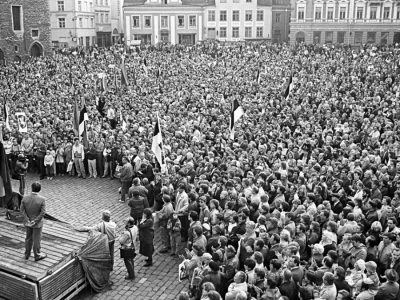Why does owning a little country house in the Russian countryside mean so much? Because, who doesn’t want to tell all their friends that they are the proud owners of a dacha. While these houses long stood to symbolize privilege and wealth, under new Soviet leader Khrushchev, the homes became more available for broader… Continue reading Dachas Dot the Russian Countryside →![]()
Category: 8th Weekly Edition
Centralizing Soviet Science: Akademgorodok
by •
(The Symbol of Akademgorodok: a sigma representing the sum of Soviet science with a lightning bold symbolizing the new city springing into existince) Throughout the first half of its existence, much of the Soviet Union’s power had been focused on heavy industry and military might. However, after WWII and the death of Stalin, this focus … Continue reading →
Crashing the Anti-Party
by •
A general theme in transitions of power is this, “out with the old, in with the new.” Following his ascension to First Secretary, Nikita Khrushchev pursued a policy of De-Stalinization and decentralization. These policies bolstered Khrushchev’s position within the party as well as dismantled Stalin’s lasting influence in Soviet politics. One controversial move by Khrushchev … Continue reading Crashing the Anti-Party![]()
Kossuth Rising: Resurgent Nationalism and Counterrevolution.
by •
Following the death of Josef Stalin in March 1953, the member nations of the Warsaw Pact faced an existential crisis. … More![]()
The Soviet Students Clap Back, Letter-Style
by •
Well well, if it isn’t the youth making another noteworthy appearance on my blog. Pardon my language but we’re more than halfway through the 20th Century (and the spring semester) of studying Soviet history, and these youngins have a lot to say from their knowledge and experiences influenced by things outside the Stalinist USSR! I…![]()
The Struggle for Freedom
by •
One of the most significant events to happen after Stalin’s death, was the release of prisoners from camps ran by the GULAG (Main Administration of Corrective Labor Camps). While the road of succession was full of challenges and awards, the release of prisoners created a new chapter for those who lost hope and faith in… Continue reading The Struggle for Freedom →![]()
The Semipalatinsk Test Site: A Bomb on Nation
by •
The beginning of “destalinization” put an end to many things, but the Soviet Union’s development of nuclear weapons wasn’t one of them. Given priority by Stalin, nuclear arms development was also continued by his successors, including Nikita Khrushchev. The soviets considered the nuclear program of very high importance, and in 1953, the directors were even … Continue reading The Semipalatinsk Test Site: A Bomb on Nation![]()
Work at Home,Work at Work, Always Stressed
by •
In the 1950s, a Soviet housewife was expected, first and foremost, to be a provider for her family. She was expected to take care of her children, keep her husband happy, prepare meals, make sure the house was cleaned, wash… Continue Reading →![]()
The first crack in the Iron Wall
by •
Soviet Tanks in Budapest (1956) The Hungarian Crisis was the first major threat to Soviet domination of half of Europe since the end of WWII. The Revolution began following several years of political infighting between different factions that led to the public’s grievances being ignored. Having seen some of the success that the Polish public …
“In This Way, Literature becomes the Living Memory of a Nation.”
by •
When the Stalin was taken out of Stalinism, the mold of the Soviet Union began to disintegrate. This disintegration meant that many elements of the Union that Stalin put into
